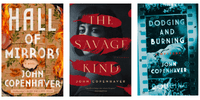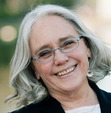A Wicked Welcome to John Copenhaver *giveaway*
by Julie, springing in Somerville
I am delighted to welcome John Copenhaver back to the blog today! He is a wonderful writer of historical mysteries, and a great member of the crime writing community. I can’t wait to read the second book in his Nightingale Trilogy.
Chasing a moodby John Copenhaver

I didn’t begin writing historical fiction because I have a great love of history. That’s not to say I don’t have deep respect for historians, especially those who explore beyond traditionally accepted narratives about a time, place, or type of people. As a gay man, I’m aware of how misunderstood the histories of LGBTQ+ people have been—and, frankly, continue to be. However, that’s not why I was drawn to write about post-WWII America and, more specifically, the 1950s in my new novel, Hall of Mirrors.
The truth is, when I write, I’m chasing a mood. It’s lush, dark, and claustrophobic. Think of the shadowy, rain-slick streets in your favorite film noir, such as The Killers (1946) or Out of the Past (1947). But it’s also shimmering with color, a baby blue satin dress rippling in the breeze, cherry blossom petals blown from a tree by an approaching storm, like imagery from a Douglas Sirk film. I love movies and, as a writer, have a cinematic style. I think in scenes and imagery, as much as in characterization. Like my favorite films, I want to create a definite mood in the reader’s mind that connects to a central theme: how surfaces deceive and how the moral absolutes they often offer us are, well, more complicated than they first appear.
Historical framework and fine detail help establish a period’s culture—its aspirations and anxieties, and its triumphs and disgraces. The glossy superficiality of the 1950s covered up deep and unacknowledged trauma caused by the Second World War and heightened by the looming threat of atomic annihilation that brought on the Cold War.
It’s true. In fiction, we need to convey a historical period’s social and political dimensions. It’s a requirement of the subgenre, I would argue. However, we also need to employ imagery that accumulates to create a distinct mood because it’s the mood that communicates how historical facts translate into emotions, and emotions all too often run the world. As a writer of historical fiction, I was drawn to the post-war mood because it resonates with digital media’s glossy and deceptive surfaces and with my journey to make myself seen in a straight-biased world. I was chasing a mood that once suffused mid-century America and is again with us today.
What mystery novels have you read that have unforgettable moods? What was it about the mood that has stuck with you? I’ll send two commenters a copy of Hall of Mirrors, U.S. only.
Bio:
John Copenhaver is the award-winning author of Dodging and Burning and The Savage Kind and is a co-founder of Queer Crime Writers. He co-hosts on the House of Mystery Radio Show and is a faculty mentor at the University of Nebraska’s Low-Residency MFA. His new novel is Hall of Mirrors.
Hall of Mirrors blurb:When a popular mystery novelist dies suspiciously, his writing partner must untangle the author’s connection to a serial killer, in award-winning John Copenhaver’s new novel set in 1950s McCarthy-era Washington, DC.
Buy link:
https://johncopenhaver.com/order-hall-of-mirrors
 Socials:
Socials:Instagram: @johncope74
Twitter: @johncopenhaver
TikTok: @johncope74
Website: www.johncopenhaver.com



